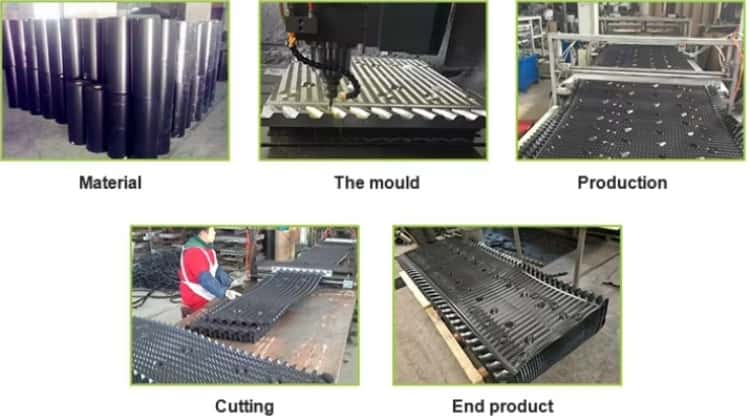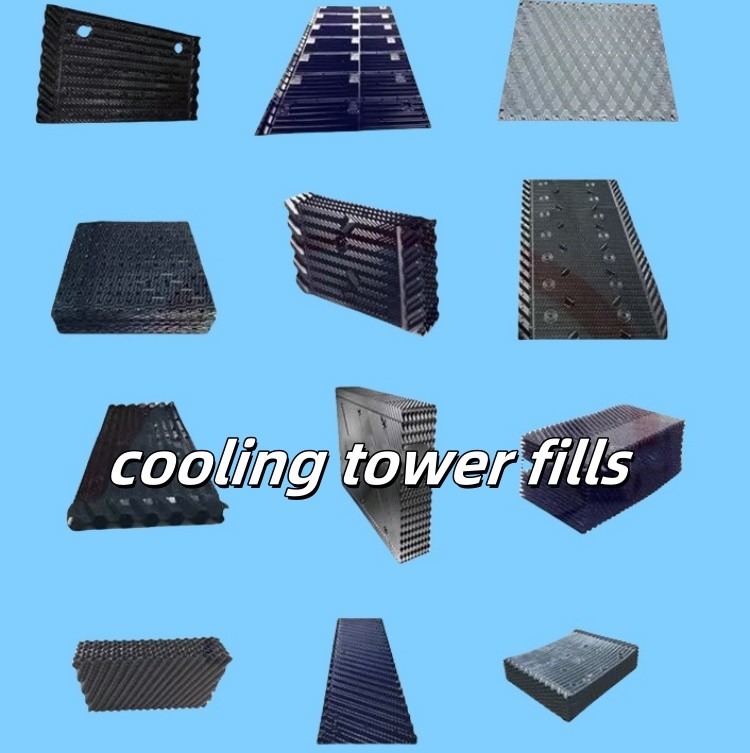Cooling towers are devices used to remove heat from industrial equipment or buildings, and are widely employed in environments where temperature control is necessary, such as power plants, petrochemical refineries, manufacturing facilities, HVAC systems, and large commercial buildings. The primary function of a cooling tower is to cool warm water through an evaporative cooling process, releasing heat into the atmosphere and lowering the water temperature so it can be recirculated back into the system, ensuring proper operating conditions for equipment.
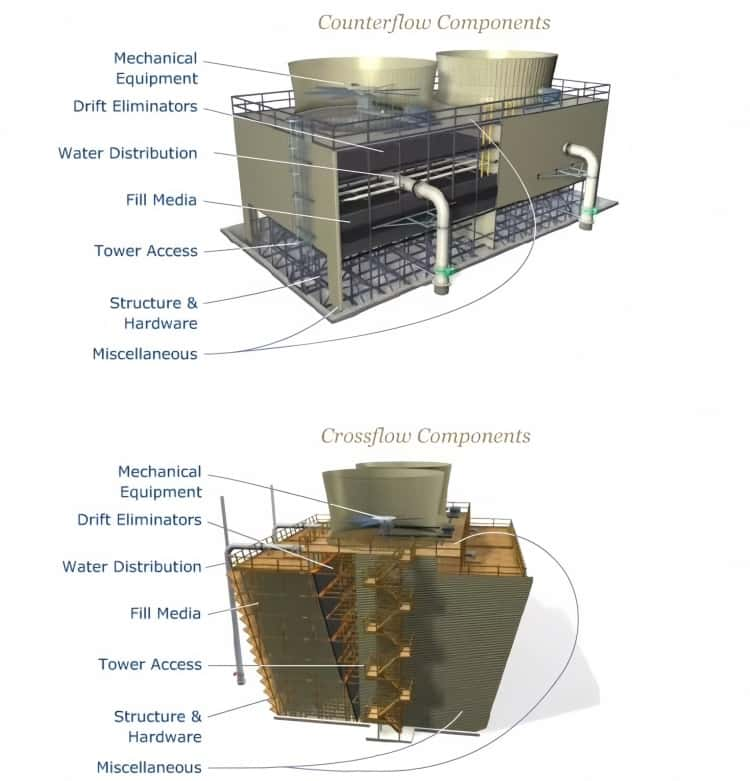
Cooling tower fill is a key component used in cooling towers to enhance their performance by increasing the surface area available for heat exchange. The primary function of the pvc fill is to maximize the contact between water and air, allowing for greater evaporation and more efficient cooling. Through this article, you will get a comprehensive understanding of cooling tower fill.
1. Introduction to Cooling Tower Fill
Cooling tower fill designed to facilitate heat exchange between the water and air, thereby cooling the water efficiently. In a cooling tower, warm water is distributed over the fill media, which helps to break the water into thin layers or droplets. Cooling tower fill increased surface area allows the water to interact more effectively with the air flowing through the tower. As the air absorbs heat from the water, some of the water evaporates, lowering the water temperature and enabling it to be recirculated for cooling purposes.
The pvc fill for cooling tower increases the surface area of the water exposed to air, enhancing heat dissipation. Effective cooling tower fill maximizes tower performance and optimizes energy use. There are three main types: film fill, splash fill, and hybrid fill, each suitable for different applications and cooling requirements.
2. Cooling Tower Fill Types: Splash Fill vs. Film Fill
There are two main types of cooling tower fill: splash fill and film fill. Each of these designs offers unique benefits, and selecting the best type for your system depends on the specific cooling needs and water quality. Below, we’ll explore the differences between these two fill types and help you understand which one may be ideal for your application.
2.1 Cooling Tower Splash Fill
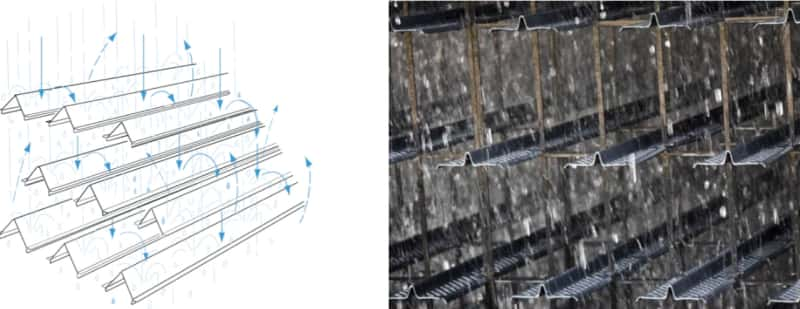
Thes Cooling tower splash fill consists of horizontal bars or slats arranged in layers within the cooling tower. When warm water flows over these bars, it spreads and breaks into small droplets. This increased surface area for water-air contact accelerates the cooling process by promoting evaporation. The more droplets formed, the more the water interacts with the air, improving heat dissipation.
Traditionally, splash fills were made from wood, but modern cooling towers often use PVC (Polyvinyl Chloride) for better performance. PVC splash fill is more durable and provides superior heat transfer compared to wood.
- Advantages of Cooling Tower Splash Fill:
- Ideal for Dirty or Impure Water: Splash fill is particularly well-suited for environments where water quality is poor or contains a high level of debris. Since the water is broken into droplets, there is no solid medium to trap dirt or particles, allowing the system to maintain its efficiency even in challenging conditions.
- Enhanced Evaporation: The formation of droplets increases air-water interaction, which speeds up the evaporation process and cools the water more efficiently.
2.2 Cooling Tower Film Fill
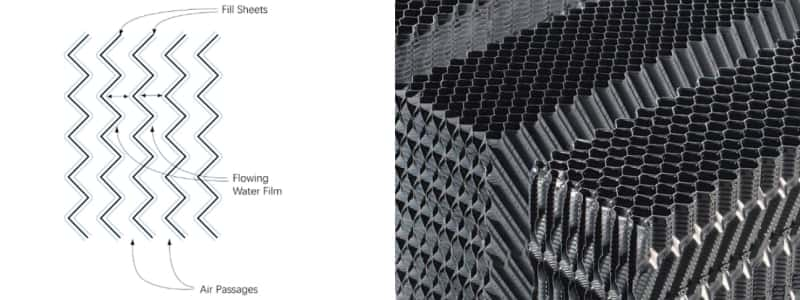
Cooling Tower Film fill consists of thin, closely spaced sheets of PVC material with a textured surface, such as flat, corrugated, or fluted designs. Water flows over these sheets in thin layers, creating a film of water that is in direct contact with the air. This maximizes the surface area for heat exchange, allowing the heat to evaporate more quickly and cooling the water faster.
- Advantages of Film Fill:
- Ideal for Clean Water: Film fill is best suited for systems that handle clean, high-quality water. The smooth surface and the thin water film allow for efficient heat transfer, but they can become clogged with debris, which may reduce performance over time. This makes it less ideal for applications where water is prone to contamination or contains particles.
- Higher Cooling Efficiency: In systems with clean water, film fill provides greater cooling efficiency due to its large surface area and consistent water flow over the sheets. The film design allows for quick evaporation and rapid heat transfer.
Hybrid Fill Design
Some cooling towers use a hybrid fill design, combining both film and splash fills. This approach allows cooling towers to benefit from the best of both designs. The film fill can handle the majority of the cooling process in systems with clean water, while the splash fill can be used where water quality is a concern, or where debris might accumulate. Hybrid designs offer a good balance of cooling efficiency and system durability, making them a versatile option for a wide range of industrial applications.
3. How Cooling Tower Fill Works
Cooling towers operate on the principle of heat transfer. The cooling fill allows water to spread into thin layers, maximizing air contact. The interaction between air and water dissipates heat as the air absorbs and evaporates some of the water, leaving the remaining water cooler. The cooling fill's design influences how much water can be cooled, airflow rates, and overall system efficiency.
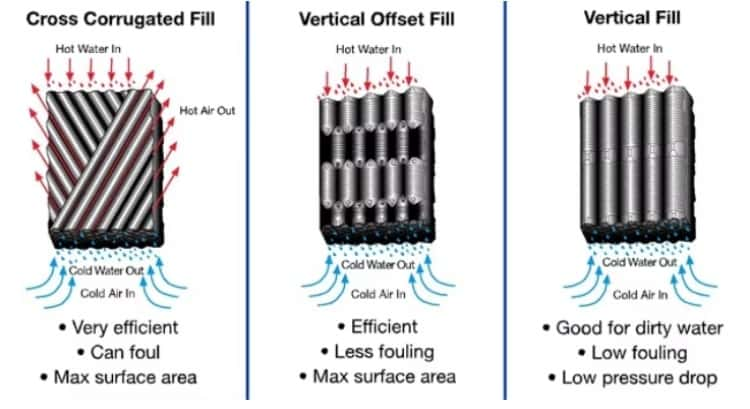
3.1 Heat Exchange Mechanism
The fill’s structure breaks water droplets into a thin film, enhancing contact with moving air, which increases evaporation and cooling.
3.2 Role of Cooling Tower Fill
Fill improves the system by maximizing surface area contact and controlling water flow to reduce energy requirements.
3.3 Impact on Water Flow and Air Contact
Proper fill design ensures optimal distribution of water across the fill surface, critical for maximum cooling efficiency.
4. Cooling Tower Fill Material
Cooling tower fills come in various materials, tailored to different operational environments and durability needs.
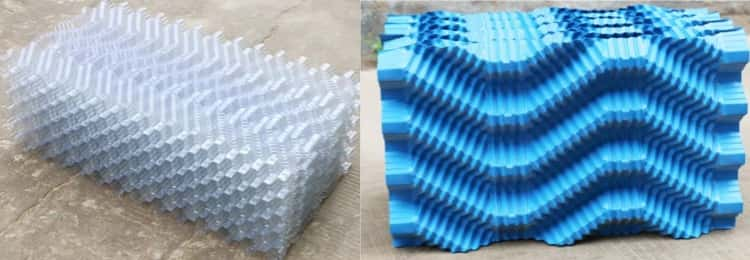
4.1 PVC (Polyvinyl Chloride) Fill
PVC cooling tower fill is widely used due to its durability, resistance to chemical corrosion, and cost-effectiveness.
4.2 PP (Polypropylene) Fill
PP cooling tower fill is suitable for high-temperature environment.
4.3 Hybrid and Custom Fill Materials
Materials like stainless steel or ceramics may be used for specific needs, such as in highly corrosive or high-temperature environments.
4.4 Material Selection
The choice depends on water quality, temperature, and chemical exposure. PVC remains popular due to its versatility.
5. Cooling Tower Fill Design Variations
The structure and design of cooling tower fills significantly affect performance and maintenance needs.
5.1 Film Fill Variants
Cross-fluted film fills create a high degree of turbulence, while Vertical Fluted Fills are better for applications where debris may be present, as they resist clogging.
5.2 Splash Fill Variants
Splash fills create droplets instead of a thin film, ideal for water with high debris content. Types include grid, slat, and bar designs, each with unique water break-up characteristics.
5.3 Design Impact
Different designs affect maintenance; for example, splash fills are more accessible for cleaning and repair, making them suitable for areas with hard water or high debris.
6. Benefits of Using High-Quality Cooling Tower Fill
High-quality fill enhances cooling efficiency, reduces maintenance needs, and extends the lifespan of the cooling tower.
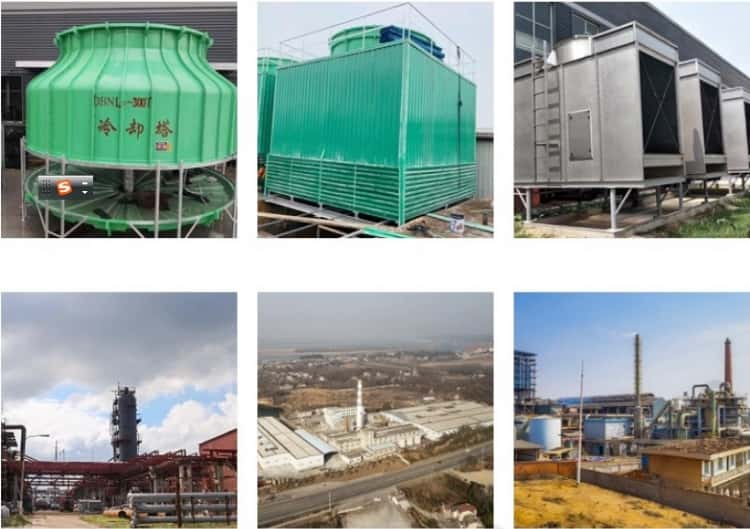
6.1 Enhanced Heat Transfer Efficiency
A well-designed fill maximizes water-air interaction, leading to faster heat dissipation and lower energy costs.
6.2 Reduced Water Usage
High-efficiency fills reduce water loss through optimized evaporation processes, contributing to lower operational costs.
6.3 Improved Flow Dynamics
Properly configured fills promote ideal water and air flow, ensuring even distribution and preventing hotspots.
6.4 Durability
Quality fill materials resist wear and chemical degradation, minimizing downtime and the need for frequent replacements.
7. Cooling Tower Fill Installation and Maintenance
Proper installation and maintenance of cooling tower fill extend its service life and efficiency.

7.1 Installation Requirements
Fill installation demands alignment with tower specifications to ensure optimal water flow and prevent leakage. Correct installation minimizes the risk of thermal inefficiency.
7.2 Best Practices for Prolonging Fill Life
Regular inspections for clogs or debris buildup and cleaning schedules prevent blockages, ensuring consistent performance.
7.3 Maintenance and Replacement
Regular cleaning and periodic replacement are essential. Non-corrosive materials are easier to clean and withstand chemical treatments.
7.4 Common Issues and Troubleshooting
Problems such as clogging, biofilm formation, and wear from chemicals are common; regular inspections and addressing issues early extend fill lifespan.
8. Selection Guide for Cooling Tower Fill
When selecting the cooling tower fill, it is also essential to consider the proper sizing and angle for optimal performance.
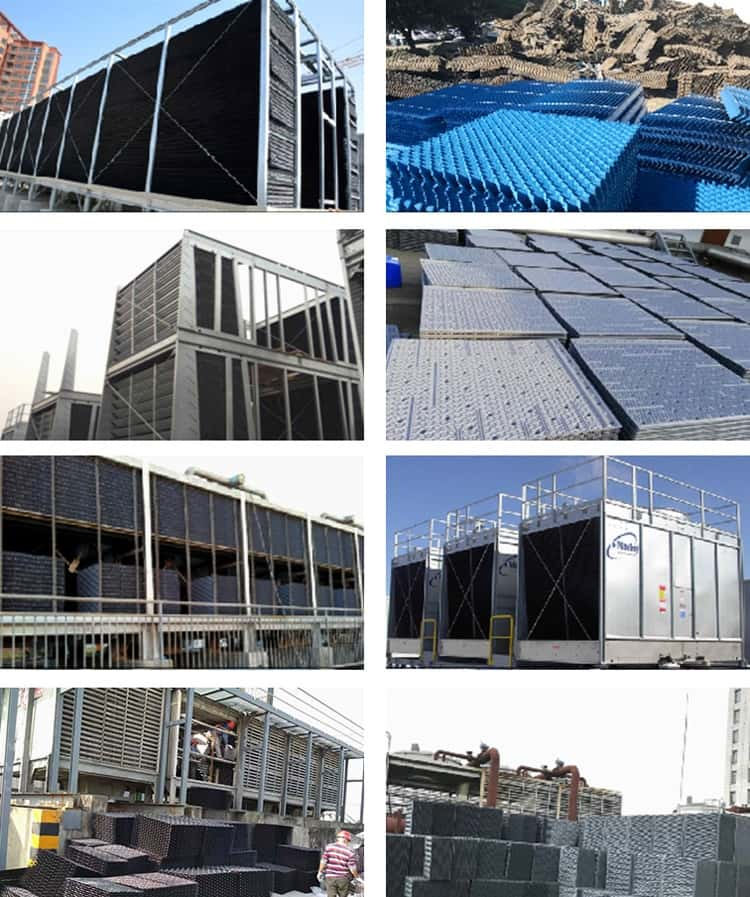
8.1. Standard Dimensions for Crossflow Cooling Towers:
PVC Filling For crossflow cooling towers, the distance between the top of the honeycomb pvc fill and the bottom of the fan should be 1.5 times the diameter of the fan. This ensures that the airflow is distributed efficiently across the fill media for maximum heat dissipation.
8.2. Recommended Angles for Counterflow Cooling Towers:
For counterflow cooling towers, there are specific angle recommendations to optimize the flow of water and air:
The top of the fill media should be positioned at an angle no more than 90 degrees with the airflow section. A deflector coil should be installed, and the roof cover should be flat.
The angle between the airflow section and the water eliminator should be between 90° and 120°.
For conical tower tops, the angle at the top of the conical section should be adjusted between 90° and 110°.
The water injection angle should be controlled within a range of 5 to 8 degrees.
The decision to use splash or pvc film filling for cooling tower depends on several factors, including water quality, temperature, and environmental conditions. Here are some key considerations:
Water Quality: If the water contains impurities or high levels of solids, splash fill is a better choice. Its design helps prevent clogging and maintains efficiency even in the presence of debris. In contrast, film fill is ideal for clean water applications where the risk of clogging is minimal.
Temperature Conditions: If the water temperature is extremely high, splash fill made with durable materials such as metal bars may be a better choice as film fill can wear out prematurely under such conditions.
Cooling Efficiency: If the cooling tower handles clean water, film fill is generally more efficient due to its larger surface area for heat exchange.
Maintenance and Durability: Splash fill is often more durable and easier to maintain in environments where water quality is subpar. However, film fill requires more maintenance when the water is not well-maintained, as debris accumulation can significantly reduce its efficiency.
Backup Circulation System
It is important to activate a backup circulation system to prevent air short-circuiting at the bottom of the fill media during operation. This ensures that the cooling tower maintains its cooling capacity under all conditions.
Special Considerations for Cold Climates
In regions with cold climates, it is essential to choose fill materials with high cold resistance. This is because low temperatures can affect the performance of the fill media, and using the wrong type of fill can lead to inefficiencies or even damage. The heat and cold resistance of the cooling tower fill should be verified through a comprehensive analysis of the fan and cooling tower design. Proper calculations should be made to determine the best material for the specific climate and operating conditions.
Choosing the right cooling tower fill is crucial for optimizing the performance, efficiency, and longevity of the cooling tower. Understanding the differences between splash and film fill media, and considering the factors of water quality, temperature, and climate conditions, will help you make the best decision for your system. Proper installation, maintenance, and material selection will ensure that your cooling tower operates efficiently and effectively, reducing downtime and operational costs.
9. Cooling Tower Fill Replacement
Over time, the cooling tower fill media can degrade, reducing its ability to cool effectively. Knowing when to replace the fill media, understanding the benefits of replacement, and following the correct procedure for replacement are crucial for maintaining optimal cooling tower performance.
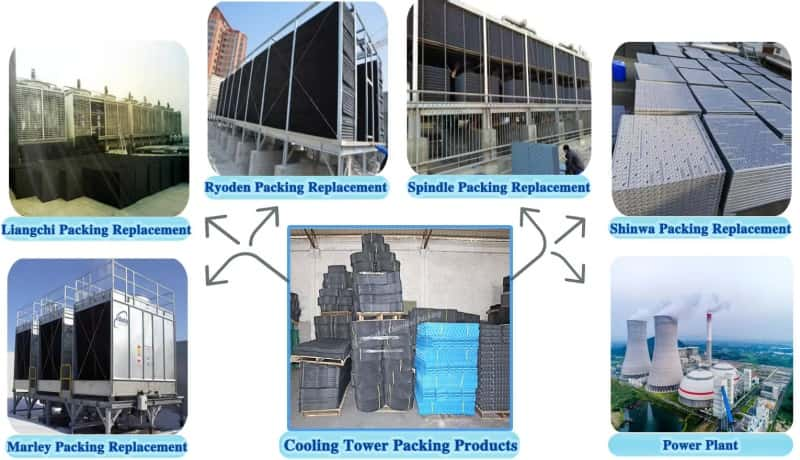
9.1 Signs That Cooling Tower Fill Media Needs to Be Replaced
So it's essential to monitor the condition of the cooling tower fill to identify when it’s time for a replacement.
Here are some key signs that the fill media may need to be changed:
- 9.1.1 Calcium Buildup
Water used in cooling towers often contains calcium and other minerals. Over time, these substances can accumulate on the fill media, forming scale. This buildup can restrict airflow and hinder the water’s ability to spread evenly over the fill. As a result, both air and water flow become less efficient, and the cooling tower’s performance decreases. - 9.1.2 Uneven Water Distribution
If the fill media becomes clogged or blocked, the water will not be distributed evenly across the surface of the fill. This can lead to inefficient cooling, as certain areas of the fill may be starved of water, while others may experience excessive flow. Uneven water distribution is often caused by a buildup of debris or scale, or physical damage to the fill media itself. - 9.1.3 Increased Energy Usage
As the fill media deteriorates and the cooling tower becomes less efficient, the system will consume more energy in an attempt to meet the cooling demands. The reduced heat transfer capacity means the cooling tower has to work harder, using more energy to achieve the same results. As a result, you may notice higher electricity bills despite the cooling tower’s diminished performance.
9.2 How to Replace Cooling Tower Fill Media: Step-by-Step Process
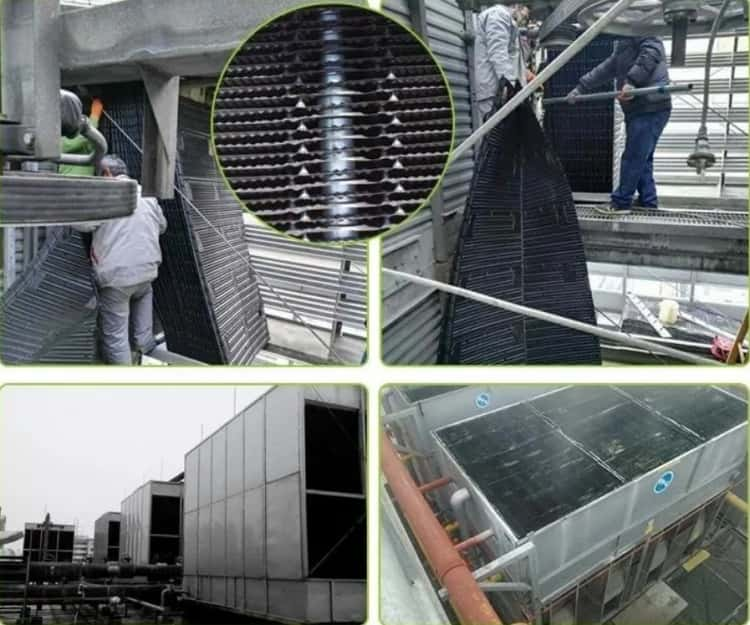
Replacing the pvc filler media in a cooling tower requires a methodical approach to ensure the system functions efficiently after the replacement. Here is a step-by-step guide for replacing the fill media:
- 9.2.1 Shut Down the Cooling Tower
Before beginning the replacement, ensure that the cooling tower is fully shut down. Turn off both the water circulation and the electrical systems to avoid any accidents during the replacement process. - 9.2.2 Drain the Cooling Tower
Drain all water from the cooling tower to avoid spills or flooding during the replacement. This will also allow easier access to the fill media for removal. - Remove the Old Fill Media
Carefully remove the old fill media. Depending on the design of the tower, you may need special equipment such as cranes or lifting devices to remove large sections of the media. Be sure to clear out any debris, scale, or dirt before proceeding. - 9.2.3 Inspect the Tower Components
While the old fill media is removed, inspect the remaining components of the cooling tower, including the fans, water distribution system, and drift eliminators. Clean or replace any components that show signs of wear or damage to ensure optimal performance once the new fill media is installed. - 9.2.4 Install the New Fill Media
Install the new pvc fill media according to the manufacturer's instructions. Ensure that the fill is correctly positioned to maximize air and water contact. Depending on the cooling tower design, you may need to adjust the fill placement to ensure even water distribution and airflow. - 9.2.5 Test the System
Once the new fill media is installed, test the cooling tower to ensure everything is functioning correctly. Check for any leaks, ensure even water distribution, and verify that the airflow is optimal. Make adjustments if necessary. - 9.2.6 Monitor Performance
After the fill media replacement, continue to monitor the cooling tower’s performance regularly. Keep an eye on water temperature, energy consumption, and overall cooling efficiency to ensure that the new fill media is working as expected.
10. Conclusion
Cooling tower fill plays a crucial role in maintaining efficient cooling tower operations by facilitating effective heat exchange and supporting optimal water and air flow. Through careful material selection, design, and maintenance, cooling towers can achieve enhanced performance, durability, and environmental compliance.
